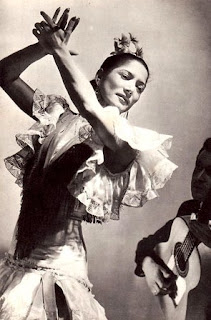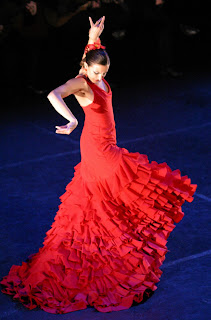Image courtesy of: http://www.arshtcenter.org/
One of Spain's most characteristic cultural elements, the historical developments of Andalusia's flamenco music and dance, is deeply rooted in its historical, southern past. The cultural contributions of Spain's myriad populations, who immigrated into the Iberian peninsula long ago and have included East Indian, Moorish and Jewish communities, were absorbed into the dominant culture. Similarly and in distant centuries, when much of Spain was under the reign of the Moors, Mozarabic musical melodies and instruments were adapted by its other resident minorities, the Christians and Jews (later still, by the Gypsies) - all of whom were, at one time or another, outcasts, persecuted either at the end of Arab rule or during the Spanish Inquisition. The birth of flamenco was, consequently, the voice of protest of these conquered peoples; an emotional and cultural expression born under the yoke of subjugation of some successive dominant rule or the other. It is, therefore, a hybrid mixture of all those diverse cultural musical elements: Arabic, Jewish, Christian and Gypsy. It was not until the 18th century that flamenco dance - hitherto illegal and in the shadows of flamenco song and music, performed mainly in and for small groups of Gypsies, oftentimes in secret locations to avoid detection by the authorities - came into being as a structured dance.
(Sources: centroflamenco.com, 2010; enforex.com, undated; Rutuja, J., buzzle.com, 2010)
Image courtesy of: http://www.spainparador.com
There is no clear indication of the history of the word flamenco, but various theories persist, with some expounding the origin as hailing from the Arabic-Hispanic word, fellahmengu, which means 'expelled people.' At one point in time, near the end of the Moorish reign in Spain (lasting from 712-1238 A.D.), the term was used to refer to Andalusia's Muslim population. Others propose that the term, flamenco, may have derived from Jewish origins and which may be translated as Flemish in Spanish. Many Jews who, preferring to emigrate to more tolerant countries rather than undergo a conversion under Spain's Christian rulers in the 15th century, settled in Flanders where they were allowed the liberty of chanting their traditional religious melodies unmolested. These same songs or chants were referred to as flamenco by their next-of-kin, left behind in Spain. It was only later on that the term flamenco came to be associated with the less desirable and derogatory racial attributes applied to marginalized groups of Andalusian peasants - anything which was loud, scandalous, libertarian or in bad taste. (Sources: centroflamenco.com, 2010; Rutuja, J., buzzle.com, 2010)
Image courtesy of: http://www.costelloentertainments.co.uk/
Whatever theory applies to the origins of the flamenco cante - whether it be Gypsy, Arabic or Jewish - at the heart of it are three basic principles: jondo or grande (meaning profound or deep) pertain to the intense sentiments of sadness involving persecution, death and loss, anguish and despair; intermedio (intermediate), though less intense or profound but is still moving, with an oriental tone of quality to the music; and finally, chico (small or light) which is concerned with the topics of love, happiness and ribald humour.
The real essence of flamenco can still be found - to the accompaniment of guitar(s), hand-clapping, and voice(s) - in the Andalusian regions of southern Spain such as Cadiz, Seville, Granada and Jerez de la Frontera, where male and female performers, both old and young, participate equally in its cultural, passionate expression at social events and celebrations such as weddings. Much as it has since it began to be performed professionally at the musical cafés cantantes of the 18th and 19th centuries, the dancer remains the prime focus of attention.
But although the performance of a flamenco song and dance depends much upon the mood (and improvisation) of the performer - who uses his or her emotional regulation to direct each performance - he or she is still expected to adhere to the strict framework of flamenco's rhythmic patterns. The dancer (bailaor or bailaora) will often spend the first few minutes of a performance standing motionless, absorbing the strums of the guitar and the rhythms of the clapping hands and voices, waiting for inspiration to move him or her to begin the dance - to physically convey with his or her body the emotional significance of the song's lyrics. (Sources: centroflamenco.com, 2010; enforex.com, undated)
Dancer, Carmen Amaya
Image courtesy of: http://www.voiceofdance.com/
There is still to be found a unique song and dance form, the Peteneras. The Sephardic Jews, expelled from Spain at the end of the 15th century and who found new settlements in Turkey and other Middle Eastern and Balkan countries, still speak what is called Ladino - a composite of old Spanish with many Jewish words and terms thrown into the mixture - and who still conserve many of their ancestral (Spanish) customs and traditions. The Peteneras still sing many songs very similar in sound to what is identified as flamenco cantes or songs, which are said to have been passed down from generation to generation since the Jewish expulsion from Spain. It is considered that the Peteneras, which today forms part of the flamenco repertoire, itself originated as a Sephardic song. To this day, Gypsies refuse to sing or dance the Petenera, deeming it unlucky to do so (a belief associated with the fact that the Sephardic Jews - the original interpreters of this type of song - were persecuted and anyone singing such songs of Jewish origin would also be condemned to suffer a similar fate). (Source: centroflamenco.com, 2010)
Dancer, Carmen Mota
Image courtesy of: http://www.koreatimes.co.kr/
Dancer, La Magdalena
Image courtesy of: http://wweek.com/
Dancer, Manuela Vargas
Image courtesy of: http://www.deflamenco.com/
Image courtesy of: http://www.centroflamenco.com/
Image courtesy of: http://www.kidsdanceshoes.com/
Image courtesy of: http://www.waterfront.co.uk/
Image courtesy of: http://dcist.com/
Image courtesy of: http://www.camarondelaisla.org/
Dancer, Rosario Toledo
The above four images are courtesy of: http://www.frankvanheertum.nl/
Flamenco dancer twirling the "manton" in Jerez, Spain
Photo by Rafael Aviles
Image courtesy of: http://reddit.wired.com/
Image courtesy of: http://www.scenicreflections.com/
Video courtesy of: zaknata ~ youtube.com
Video courtesy of: VonTluczkus ~ youtube.com
Video courtesy of: StudioAndalucia ~ youtube.com
Suggested readings:
Flamenco: Gypsy Dance and Music from Andalusia (1996), by Claus Schreiner & Madeleine Claus: Amadeus Press
Gypsies and Flamenco: The Emergence of the Art of Flamenco in Andalusia (2003), by Bernard Leblon: University of Hertfordshire Press
Songs of the Outcasts: An Introduction to Flamenco (2003), by Robin Totton: Amadeus Press
Flamenco Dance: Secrets of the Professionals (2005), by Paco Sevilla: Sevilla Press
The Art of Flamenco (2005), by Donn E. Pohren: Bold Strummer Ltd.
Flamenco: Conflicting Histories of the Dance (2009), by Michelle Heffner Hayes: McFarland





















No comments:
Post a Comment